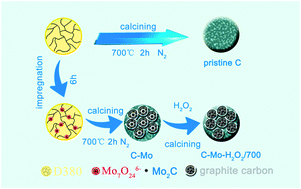Porous graphitic carbon prepared from the catalytic carbonization of Mo-containing resin for supercapacitors
Abstract
A polystyrene-based ion exchange resin was utilized to recover Mo from wastewater, and the Mo was used as a catalyst and template to produce porous graphitic carbon possessing a large specific surface area and high electronic conductivity at moderate temperature. Further H2O2 oxidation leads to an increase in the pore volume due to the removal of molybdenum carbide and the partial oxidation of the porous carbon, resulting in a considerable enhancement of the specific capacitance.


 Please wait while we load your content...
Please wait while we load your content...